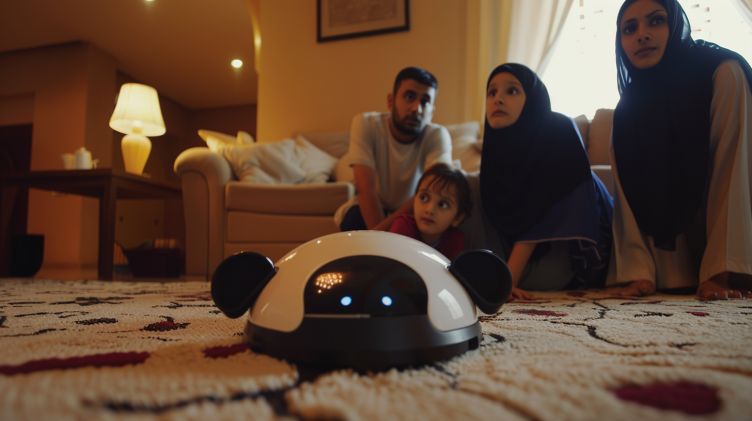Muscat: In our quest for convenience, we have embraced technology that seamlessly integrates into our homes. Yet, as we invite these smart devices into our sanctuaries, we must confront an unsettling reality. The very tools designed to enhance our lives may also be compromising our privacy in profound and dangerous ways.
Consider the case of the modern robot vacuum, an unassuming appliance designed to keep our floors spotless. This device, equipped with cameras and sensors, is much more than a simple cleaner. It maps your home in detail, capturing not just the layout but the location of your furniture and even the people in the house. These maps, stored and updated regularly, can be a treasure trove of information if they fall into the wrong hands.
In December 2022, MIT Technology Review published a scandalous exposé revealing how the mundane routines of people’s everyday lives were exposed online without their consent. One image captured a woman in a compromising situation, using the bathroom. Another showed a child sprawled on the ground, his face fully visible. These photos, taken by a beta version of iRobot’s Roomba J7, were posted on social media, highlighting a significant breach of privacy.
Read More
- UAE deepens AI ties as Sheikh Mohamed meets OpenAI CEO Sam Altman
- Over 1.4 billion accounts hacked monthly worldwide: Cyber Security Council
- Meet Abidur Chowdhury: The Bangladeshi designer who gave the world the iPhone Air
- First look: Apple unveils iPhone 17 series with brighter displays, slimmer design, and AI upgrades
- Apple CEO Tim Cook announces new stores in Bengaluru and Pune
The images captured by the Roomba were sent to Scale AI, a startup that contracts workers around the world to label data used to train artificial intelligence. This practice highlights a sprawling global supply chain for data from our devices, creating significant privacy risks. Consumers regularly consent to having their data monitored on various devices without fully understanding the implications. This is often due to vaguely worded privacy policies that permit broad use of data.
The risks associated with these devices are exacerbated by the fact that many users are unaware of the extent to which their data is being collected and potentially misused. For instance, a beta tester for iRobot revealed that the robot vacuums not only vacuums up dust but also collects footage that is sent out for data labelling. These images are then manually labelled by workers, sometimes leading to inadvertent privacy breaches.
The process of data annotation involves human reviewers who categorize and label the data, sometimes leading to uncomfortable situations where sensitive images are viewed and potentially shared. Capturing faces, especially those of minors, is inherently privacy-violating. Faces can be used to identify individuals across different contexts, posing long-term privacy risks. The use of biometric data like faces is subject to stricter privacy laws, and the collection of such data from children raises additional legal and ethical concerns.
Additionally, research by the University of Maryland demonstrated the potential for remote hacking of these devices. They showed how a robot vacuum’s navigation system could be used to collect audio data, including identifying TV shows and human speech with 90% accuracy. This means any device with light detection technology can be repurposed to collect sound, posing further privacy threats.
Even more concerning is the trend of placing these devices in sensitive areas such as meeting rooms and bedrooms. A robot vacuum in a corporate boardroom could inadvertently record confidential discussions, while one in a bedroom might capture the most private moments of our lives. Despite vendor assurances of robust encryption and security, instances have shown these devices transmitting data to external servers without user consent.
Robot vacuums are just the tip of the iceberg. In 2020, multiple class-action lawsuits were filed against Amazon after users discovered their Ring smart cameras had been hacked. Hackers were recorded talking through the camera’s speakers to the users, subjecting them to slurs and taunts. A Texas couple was asked for $350,000 in Bitcoin, while children were targeted with frightening messages.
The implications extend beyond personal privacy to the realm of targeted marketing. Data collected by smart home devices can be analyzed to discern our consumption patterns and preferences. Marketers can use this information to bombard us with tailored advertisements, exploiting our private data for commercial gain. The notion that our refrigerator or air conditioner could inform marketing strategies is a chilling reminder of how our personal lives are increasingly being commodified.
Moreover, the secondary market for these devices poses additional risks. Purchasing used smart devices from online platforms like Amazon can be a gamble. These gadgets can be easily rooted, allowing malicious actors to gain control with something as simple as a USB drive. Once compromised, a device that appears to function normally can become a spy, sending valuable data to unscrupulous entities.
As highlighted by researchers, many of these devices, including robot vacuums, can be thought of as “Raspberry Pi on wheels.” They are essentially compact computers with cameras and sensors, capable of extensive data collection and processing. Hackers find it relatively easy to gain root access to these devices, often without disassembling them. This access allows them to control the device, stop it from “phoning home,” and redirect its data streams.
The vendors are aware of privacy concerns and often attempt to downplay the risks by using euphemistic terms. Instead of calling these features “cameras,” they refer to them as “optical sensors.” However, these optical sensors function much like cameras, capturing detailed images and videos that can be misused. An example from Roborock demonstrates this: the device takes “selfies” with its optical sensors, which are essentially real photos from a camera.
The acquisition of iRobot by Amazon in August 2022 has further intensified privacy concerns. Amazon, known for its extensive data collection practices, now has access to detailed maps of users’ homes. This information could be used to infer home sizes, income levels, and even daily routines, allowing for even more precise targeted advertising.
Some people argue that their home layout is public information already, whether it’s on real estate websites or city planning. However, the details gleaned from an internal house plan can reveal much more. Using the robot vacuums, Amazon could get details such as home size—which implies income level—daily routines, and lifestyle information. The company could figure out if the home has a crib or a dog bed, then focus targeted advertisements, including baby products or dog toys, on the user.
A team of researchers from the University of Maryland tested the validity of concerns about robot vacuums listening in on users. They remotely hacked into a robot vacuum to collect audio using its navigation system, which employs Lidar technology. By applying signal processes and deep learning techniques, they were able to recover speech and identify TV series playing in the room, as well as human voices, with 90% accuracy. This demonstrates that any device with light detection technology can be made to collect sound.
Other users worry that the Roomba’s camera could be hacked. A Redditor claiming to be a beta tester revealed that live streaming was one of the features they were able to test, posting the camera footage and some stills. These concerns highlight the broader issue of privacy and security in smart home devices.
Despite certifications from respected organizations, many smart devices still pose significant security risks. For example, Roborock claims that its devices do not send camera pictures to the cloud, but the same devices offer a feature to watch pets remotely. This contradiction illustrates the need for scepticism when evaluating vendor claims. iRobot claims to have implemented privacy and security measures such as encryption and regular security patches. However, the leak of sensitive images indicates gaps in these protections.
With the increasing reliance on smart devices in our daily lives, it is essential that steps are taken to protect user data. A more proactive approach to user privacy could include increased transparency around data collection and usage, regular security audits, and more robust data processing agreements when involving third-party companies.
As consumers, we must also consider our personal privacy and how our data is used when selecting devices for our homes. After all, we don’t want to be left in the dust when it comes to protecting our privacy. The onus is on both companies to clean up their act and consumers to make informed decisions.
In an era of unprecedented technological capability, the potential for misuse is equally unprecedented. As we embrace the benefits of smart devices, we must also remain vigilant against the risks they pose. Our privacy, security, and, ultimately, our way of life depend on it.







